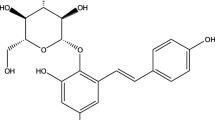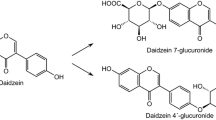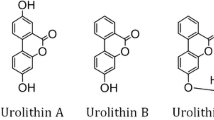Abstract
Purpose. The aim of this study is to investigate species differences in the stereoselective hydrolysis for propranolol ester prodrugs in mammalian intestinal mucosa and Caco-2 cells.
Methods. Hydrolase activities for propranolol prodrugs and p-nitro-phenylacetate in man (age: 51−71 years), the beagle dog (age: 4 years) and Wistar rat (age: 8 weeks) intestinal mucosa, and also in Caco-2 cells (passage between 60−70) were estimated by determining the rate of production of propranolol and p-nitrophenol, respectively.
Results. The hydrolase activities for both propranolol prodrugs and p-nitrophenylacetate were in the order of man > rat >> Caco-2 cells > dog for intestinal microsomes, and rat > Caco-2 cells = man > dog for intestinal cytosol. Dog microsomes showed stereoselective hydrolysis for propranolol prodrugs, but not those from human or rat. Interestingly, both subcellular fractions of Caco-2 cells showed remarkable R-enantioselectivity except acetyl propranolol. Enzyme kinetic experiments for each enantiomer of butyryl propranolol in microsomes revealed that dog possesses both low and high affinity hydrolases. Both Km and Vmax values in rat were largest among examined microsomes, while Vmax/Km was largest in man. Finally, it was shown that the carboxylesterases might contribute to the hydrolysis of propranolol prodrug in all species by inhibition experiments.
Conclusions. The hydrolase activities for propranolol prodrugs and p-nitrophenylacetate in intestinal mucosa showed great species differences and those in human intestine were closer to those of rat intestine than dog intestine or Caco-2 cells.
Similar content being viewed by others
REFERENCES
T. Prueksaritanont, L. M. Gorham, J. H. Hochman, L. O. Tran, and K. P. Vyas. Comparative studies of drug-metabolizing enzymes in dog, monkey, and human small intestines, and Caco-2 cells, Drug Metab. Dispos. 24:634–642 (1996).
L. S. Kaminsky and M. J. Fasco. Small intestinal cytochromes P450, Toxicology 21:407–422 (1992).
M. Lefebvre, W. Homsy, G. Caille, and P. D. Souich. First-pass metabolism of diltiazem in anesthetized rabbit: Role of extrahepatic organs, Pharm. Res. 13:124–128 (1996).
A. A. Raoof, P. F. Augustijns, and R. K. Verbeek. In vivo assessment of intestinal, hepatic, and pulmonary first pass metabolism of propofol in rat, Pharm. Res. 13:891–895 (1996).
S. Yamashita, M. Yoshida, Y. Taki, T. Sakane, and T. Nadai. Kinetic analysis of the drug permeation process across the intestinal epithelium, Pharm. Res. 11:1646–1651 (1994).
M. Inoue, M. Morikawa, M. Tuboi, T. Yamada, and M. Sugiura. Hydrolysis of ester-type drugs by the purified esterase from human intestinal mucosa, Jpn. J. Pharmacol. 29:17–25 (1979).
K. Iwamoto, M. Takei, and J. Watanabe. Gastrointestinal and hepatic first pass metabolism of aspirin in rats, J. Pharm. Pharmacol. 34:176–180 (1981).
M. D. Ribadeneira, B. J. Aungst, C. J. Eyermann, and S. M. Huang. Effects of structural modification on the intestinal permeability of angiotensin II receptor antagonists and the correlation of in vitro, in situ, and in vivo absorption, Pharm. Res. 13:227–233 (1996).
T. S. Engelen, V. Delistrie, and Y. J. Schneider, Phase I and II biotransformations in living Caco-2 cells cultivated under serumfree conditions, Biochem. Pharmacol. 46:1393–1401 (1993).
Y. Garuceau, I. Davis, and J. Hasegawa. Plasma propranolol levels in beagle dogs after administration of propranolol hemisuccinate ester, J. Pharm. Sci. 67:1360–1363 (1978).
M. Shameen, T. Imai., and M. Otagiri. An in-vitro and in-vivo correlative approach to the evaluation of ester prodrugs to improve oral delivery of propranolol, J. Pharm. Pharmacol. 45:246–252 (1993).
B. D. Anderson, W. W. Chu, and R. E. Galinsky. Reduction of first-pass metabolism of propranolol after oral administration of ester prodrugs, Int. J. Pharm. 43:261–265 (1988).
M. Shameen, T. Imai, Y. Yoshigae, A. Sparreboom, and M. Otagiri. Stereoselective hydrolysis of O-isovaleryl propranolol and its influence on the clearance of propranolol after oral administration, J. Pharm. Sci. 83:1754–1757 (1994).
Y. Yoshigae, T. Imai, A. Horita, and M. Otagiri, Species differences for stereoselective hydrolysis of propranolol prodrugs in plasma and liver, Chirality 9:661–666 (1997).
O. H. Lowry, N. J. Rosebrough, A. L. Farr, and R. J. Randall. Protein measurement with the folin phenol reagent, J. Biol. Chem. 193:264–275 (1951).
I. A. M. de Lannoy, F. Barker.III, and K. S. Pang. Formed and preformed metabolite excretion clearance in liver, a metabolite formation organ: Studies on enalapril and enalaprilate in the single-pass and recirculating perfused rat liver, J. Pharmacokin. Biopharm. 21:395–422 (1993).
S. K. Yang, Y. Y. Hsieh, W. C. Chang, and J. D. Huang. Enantioselectivity of microsomal and cytosolic esterases in rat intestinal mucosa, Drug Metab. Dispos. 20:719–25 (1992).
G. L. Mosher, J. McBee, and D. B. Shaw. Esterase activity toward the diastereomers of cefuroxime axetil in the rat and dog, Pharm. Res. 9:687–689 (1992).
E. W. Morgan, B. Yan, D. Greenway, and A. Parkinson. Purification and characterization of two rat liver microsomal carboxylesterases (hydrolase A and B), Arch. Biochem. Biophys. 315:495–512 (1994).
E. W. Morgan, B. Yan, D. Greenway, and A. Parkinson, Regulation of two rat liver microsomal carboxylesterase isozymes: species differences, tissue distribution, and the effects of age, sex, and xenobiotic treatment of rats, Arch. Biochem. Biophys. 315:513–26 (1994).
H. Schwer, T. Langmann, R. Daig, A. Becker, C. Aslanidis, and G. Schmitz, Molecular cloning and characterization of a novel putative carboxylesterase, Present in human intestine and liver, Biochem. Biophys. Res. Comun. 233:117–120 (1997).
Y. Kageyama, Y. Yamazaki, A. S. Afify, Y. Ogawa, T. Okada, and H. Okuno, Stereoselective hydrolysis of xenobiotic esters by different cell lines from rat liver and hepatoma and its application to chiral prodrugs for designated growth suppression of cancer cells, Chirality 7:297–304 (1995).
A. S. Afify, Y. Yamazaki, Y. Kageyama, S. Yusa, Y. Ogawa, T. Okada, and H. Okuno, Different expression of esterase variants in rat hepatic and hepatoma-derived cell lines detected by electrophoresis, Z. Naturforsch. C. 50:664–8 (1995).
Author information
Authors and Affiliations
Rights and permissions
About this article
Cite this article
Yoshigae, Y., Imai, T., Horita, A. et al. Species Differences in Stereoselective Hydrolase Activity in Intestinal Mucosa. Pharm Res 15, 626–631 (1998). https://doi.org/10.1023/A:1011946314416
Issue Date:
DOI: https://doi.org/10.1023/A:1011946314416




